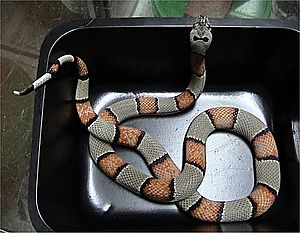Gray-banded kingsnake facts for kids
Quick facts for kids Gray-banded kingsnake |
|
|---|---|
 |
|
| Conservation status | |
| Scientific classification | |
| Genus: |
Lampropeltis
|
| Species: |
alterna
|
| Synonyms | |
|
|
The gray-banded kingsnake (Lampropeltis alterna) is a cool snake that doesn't have venom. It's also known as the alterna or the Davis Mountain king snake. This snake lives only in the southwestern United States and nearby Mexico.
Scientists once thought there were two types of gray-banded kingsnakes. They called them L. a. alterna and L. a. blairi. But now we know they are just different color patterns of the same snake!
Contents
Where Gray-Banded Kingsnakes Live
The gray-banded kingsnake makes its home in the Trans-Pecos area of southwestern Texas. You can also find it in southern New Mexico and northern Mexico. This region is mostly a desert called the Chihuahuan Desert.
What Gray-Banded Kingsnakes Look Like
These snakes are medium-sized. They can grow up to 4 feet (about 120 cm) long, but most are around 3 feet (about 90 cm). They have a head that is wider than many other kingsnakes. Their eyes are quite large with round pupils.
The colors and patterns on these snakes can be very different. There are two main color types, or "morphs." The "blairi" morph has wide red or orange bands. The "alterna" morph has thinner orange or red bands. Both types usually have a gray background. They also have white or black markings that stand out. Sometimes, you might even see a snake without any orange or red bands!
Why They Are Called "Blairi"
The "blairi" color type was named after an American scientist. His name was William Franklin Blair.
How Gray-Banded Kingsnakes Behave
It's pretty hard to spot a gray-banded kingsnake in the wild. Even though there are many of them, they are very secretive. They are also active at night. Their home is often in mountains, which makes it tough for people to explore. Finding one in nature is a big deal for snake experts, called herpetologists. Most are found on roads that go through their habitat.
These snakes are usually calm and don't bite much. They are not venomous. Plus, they are immune to rattlesnake venom, which means a rattlesnake bite won't hurt them!
What Gray-Banded Kingsnakes Eat
The gray-banded kingsnake mostly eats lizards. Sometimes, they will also eat small rodents or frogs. They might even eat the eggs of birds, lizards, or other snakes that nest on the ground.
Reproduction and Life Cycle
L. alterna snakes lay eggs. This means they are egg-laying. They usually lay 3 to 13 eggs in early summer. The eggs hatch in about 9 weeks. Each baby snake is around 10 inches (about 25 cm) long when it hatches.
Gray-Banded Kingsnakes as Pets
Many people keep gray-banded kingsnakes as pets. They are quite easy to find in the pet trade. People like them because they are not too big and have a calm nature. Also, their amazing variety of patterns makes them popular.
Many breeders try to keep different groups of these snakes separate. This helps keep their "bloodlines" pure from certain areas. But as fewer people want them, some breeders are not as strict. Sometimes, these kingsnakes are also bred with other types of kingsnakes, like the Neuvo León kingsnake (Lampropeltis leonis).





